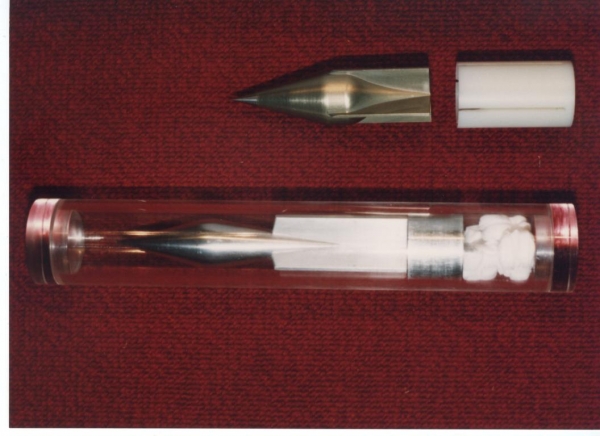One of the key variables in a ram accelerator experiment is the projectile geometry. The projectile is shaped like the centerbody of a ramjet and has fins to keep it centered inside the tube. Primary variables of interest are the projectile throat diameter (maximum projectile diameter), nose cone angle, aftbody length, base diameter, number of fins, and projectile materials. Many experiments have been carried out in the 38-mm-bore facility with the so called "standard projectile" geometry which has demonstrated a wide Mach number range of operation (i.e., 2.5 to 6 Mach). The basic features of this projectile are a 29-mm-dia throat, 10 deg nose cone half angle, 71-mm-long body, 18-mm-dia base, and 4 fins that are 3.8-mm-thick. The standard projectile is typically machined in two parts, nose cone and body, which thread together at the throat. It has been fabricated from plastics such as polycarbonate (Lexan) and Ultem and various alloys of magnesium, aluminum, and titanium. The mass of the projectile depends on the wall thickness and material; e.g., this configuration has been tested with masses ranging from from 60 to 130 g. The hollow design reduces the total mass and allows experiments to be conducted at lower fill pressures. Magnets are mounted in the nose-body joint and sometimes in the body cavity at the base of the projectile. These magnets induce signals in the tube mounted electromagnetic (EM) sensors to provide time of passage data at the instrument stations.
Parameterization studies of various projectile features have been carried out. The cone angle has been varied from 7 to 25 degrees. Throat diameter has been varied from 22 to 33 mm. Body length has been varied from 25 to 100 mm. Base diameter has been varied from 13 to 20 mm. Fin number has varied from 3 to 6 and leading edge geometry has been varied from blunt faces laid back at 10 degree rake angle to sharp knife-like leading edges normal to the flow.
One-piece projectiles with an open base have been used for high pressure (P greater than 50 atm) experiments and for investigations of superdetonative operation. Threaded plugs hold the magnets in the nose cone as shown in this projectile section view.
Aluminum-titanium hybrid projectiles, as seen below, have proven to be very effective projectiles in high pressure experiments.

A sample of the various projectile configurations fabricated at the UW is shown here.

Representative ram accelerator projectiles from other facilities are shown together in the photos below.


Obturators play a key role in the “starting process” of the ram accelerator. Mass, open area ratio, hole pattern details, and back-disk mass are the main design parameters. Perforated and solid obturators, typically fabricated form polycarbonate (Lexan), have been successfully used in ram accelerator experiments. Three-piece obturators having aluminum faceplates are used to launch small-base area projectiles.